Students’ pragmatic awareness and implications for english classroom teaching at Thuong Mai University
This study was carried out to examine Thuong Mai non-English major students’
awareness of two speech acts of requesting and greeting, their pragmalinguistic and
sociopragmatic understanding based on these speech acts. The participants were 5 Americans
and 50 non-English major freshmen at Thuong Mai University (TMU). Two survey
questionnaires were employed as research instruments. The results show that the students’
awareness of speech acts was low. The speech act of requesting comes to the fore with the
larger number of participants having the correct answers, whereas the speech act of greeting
enjoyed the lower correct response rate. The students’ understanding of pragmalinguistic and
sociopragmatic aspects was still limited. The aspect of politeness was paid the most attention
to while that of cultural norms was least focused on. A number of suggestions for promoting
students’ pragmatic awareness were given to TMU teachers and students of English.
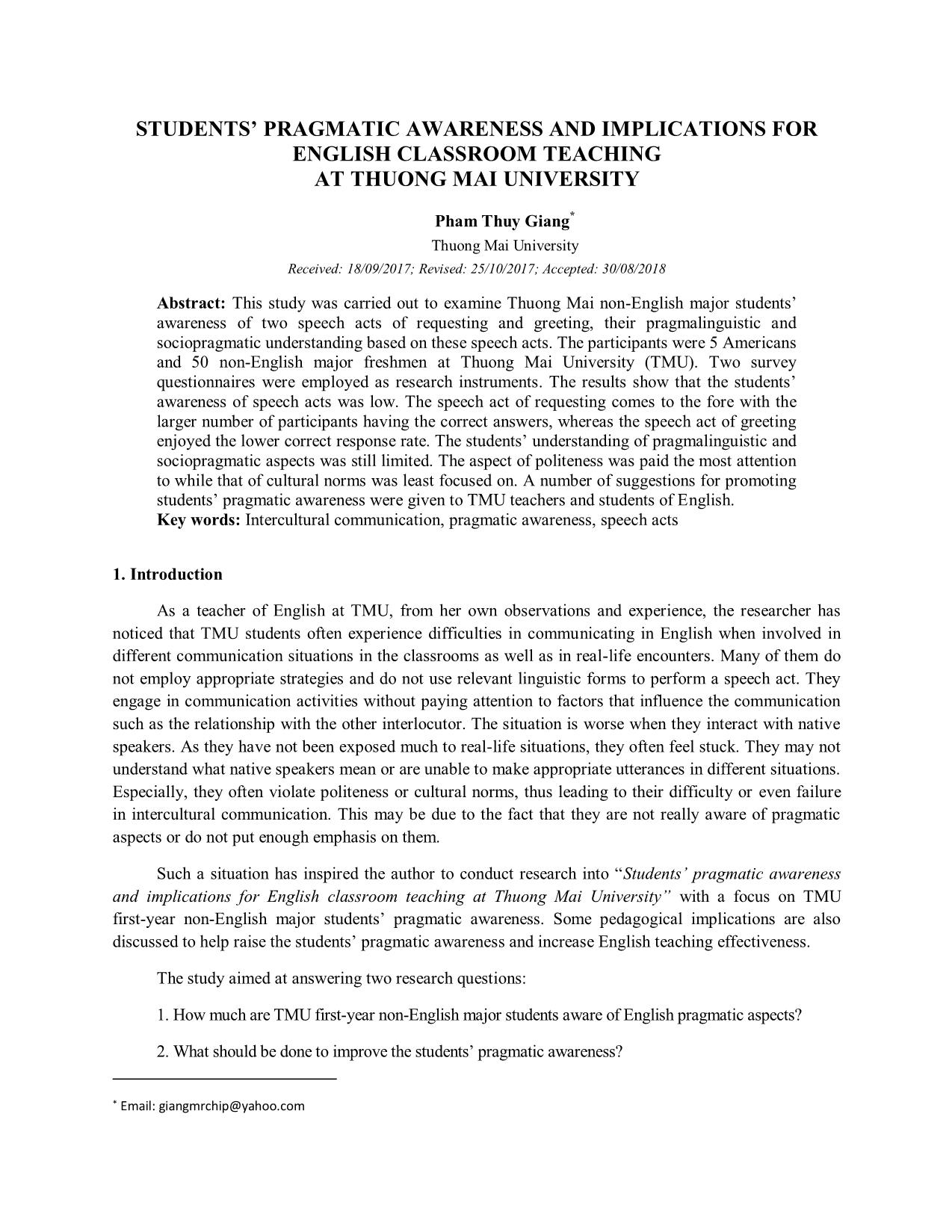
Trang 1
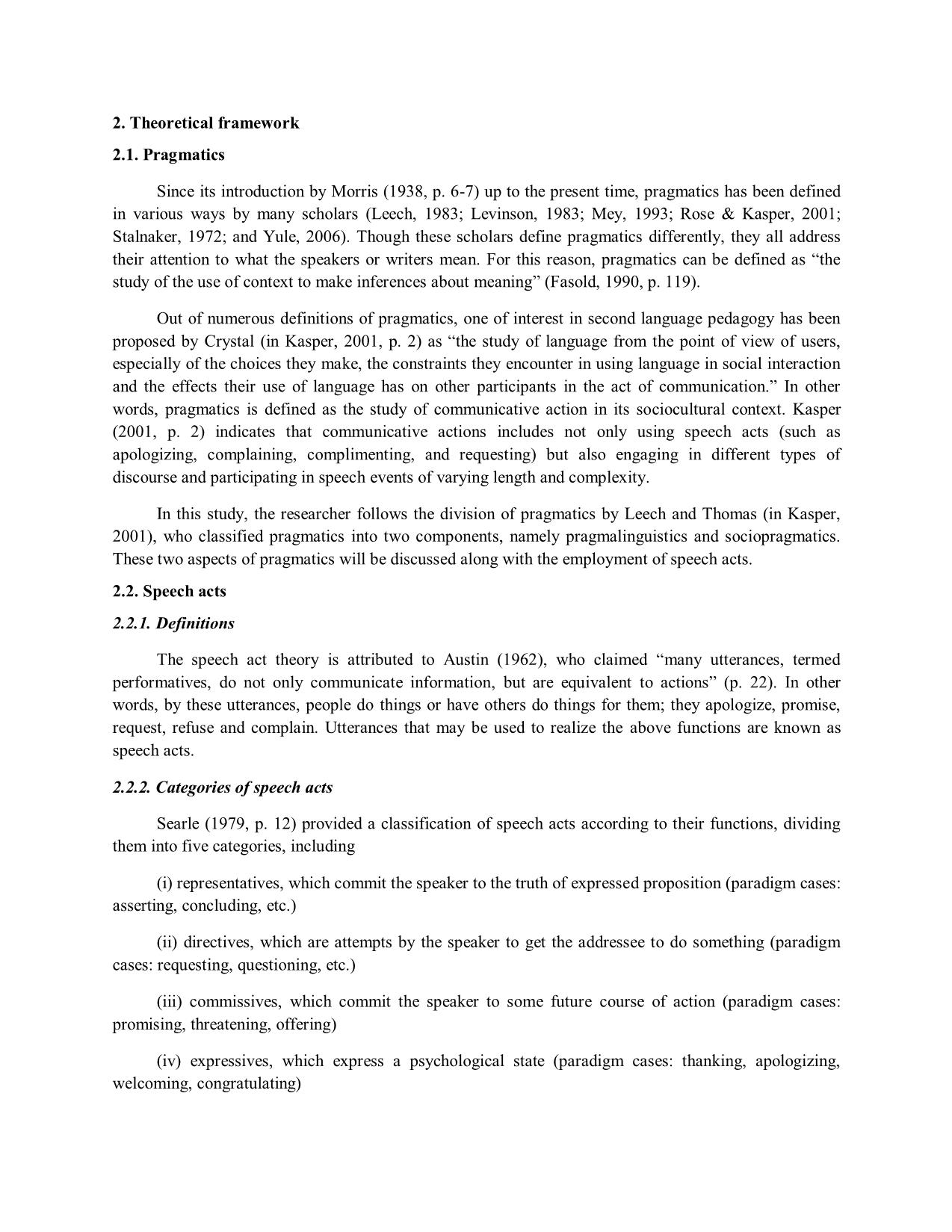
Trang 2
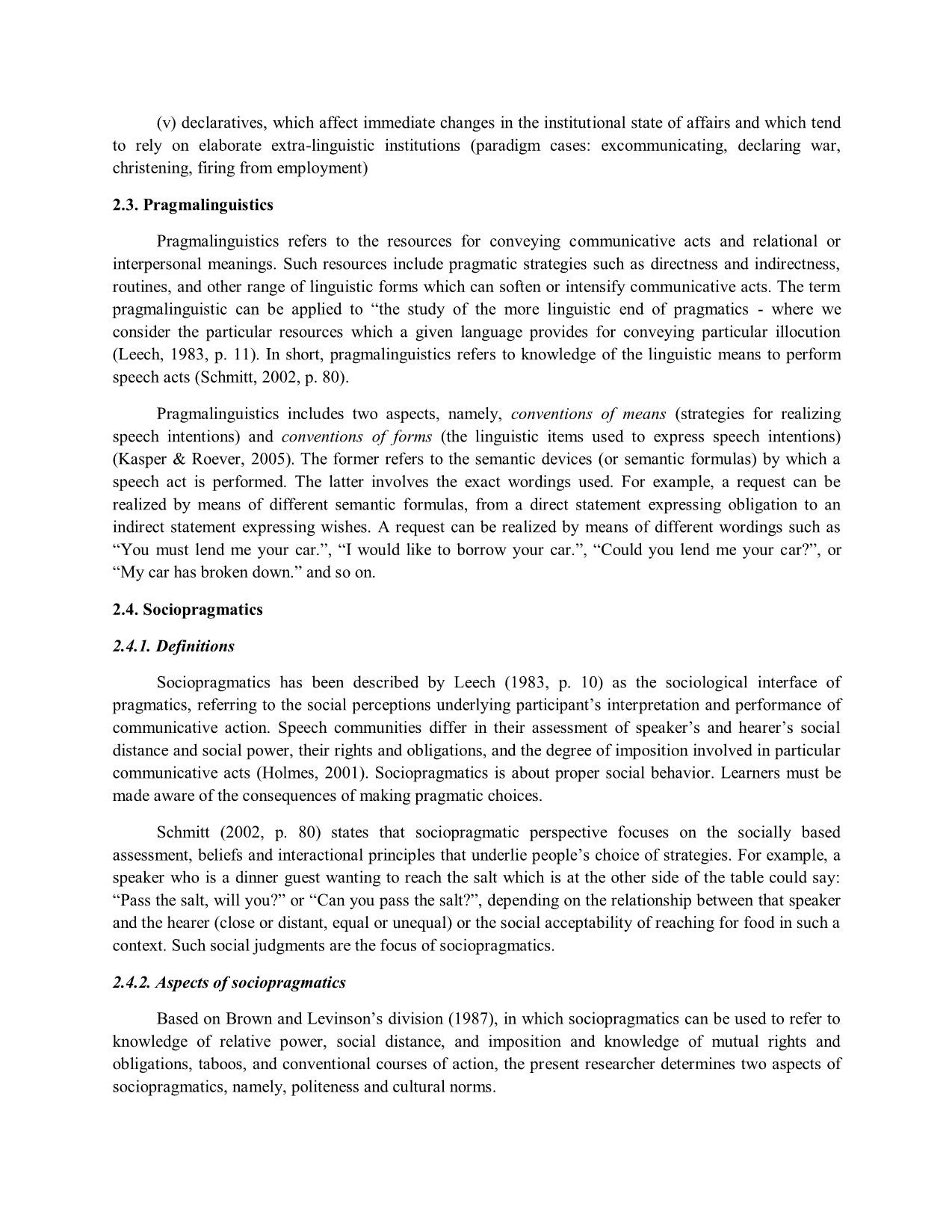
Trang 3
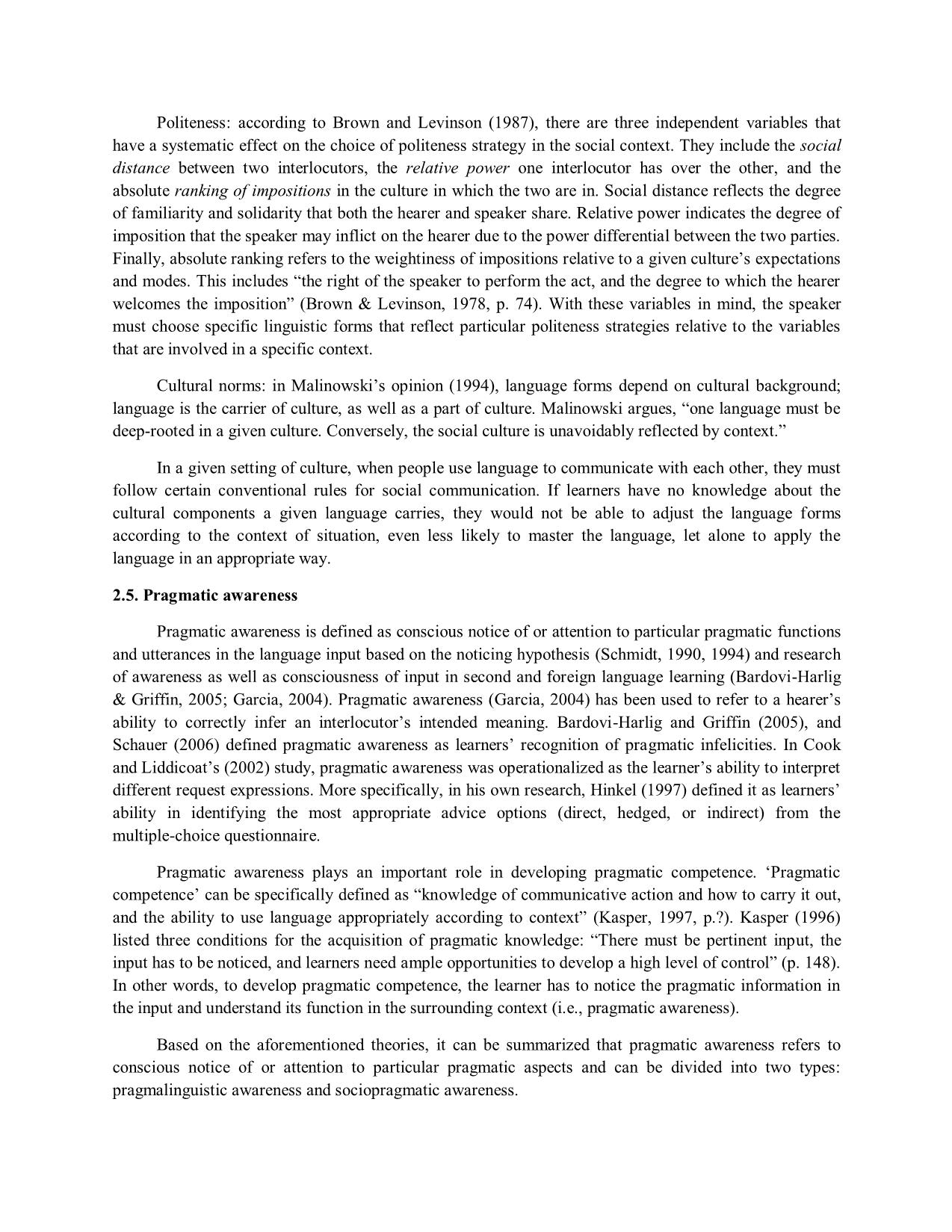
Trang 4
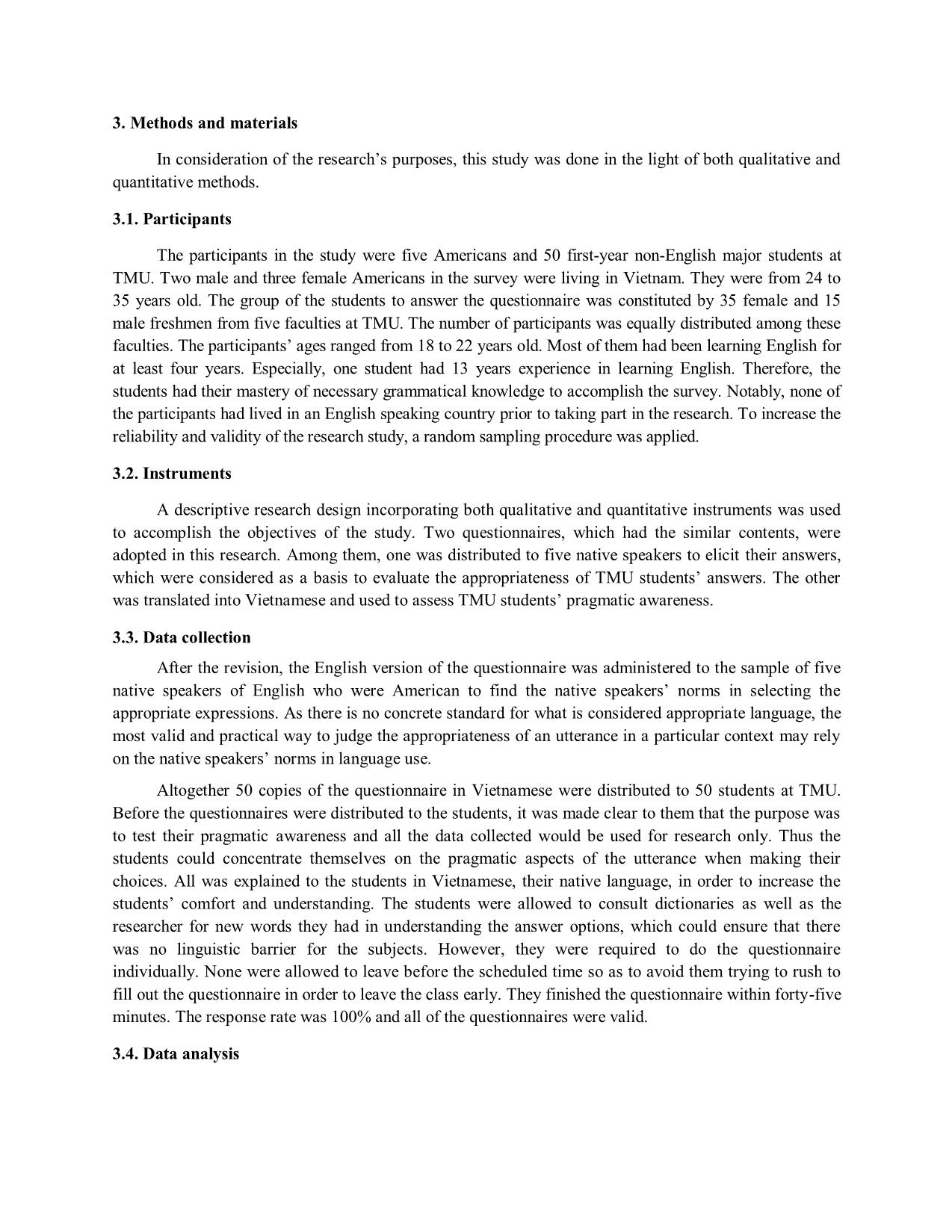
Trang 5
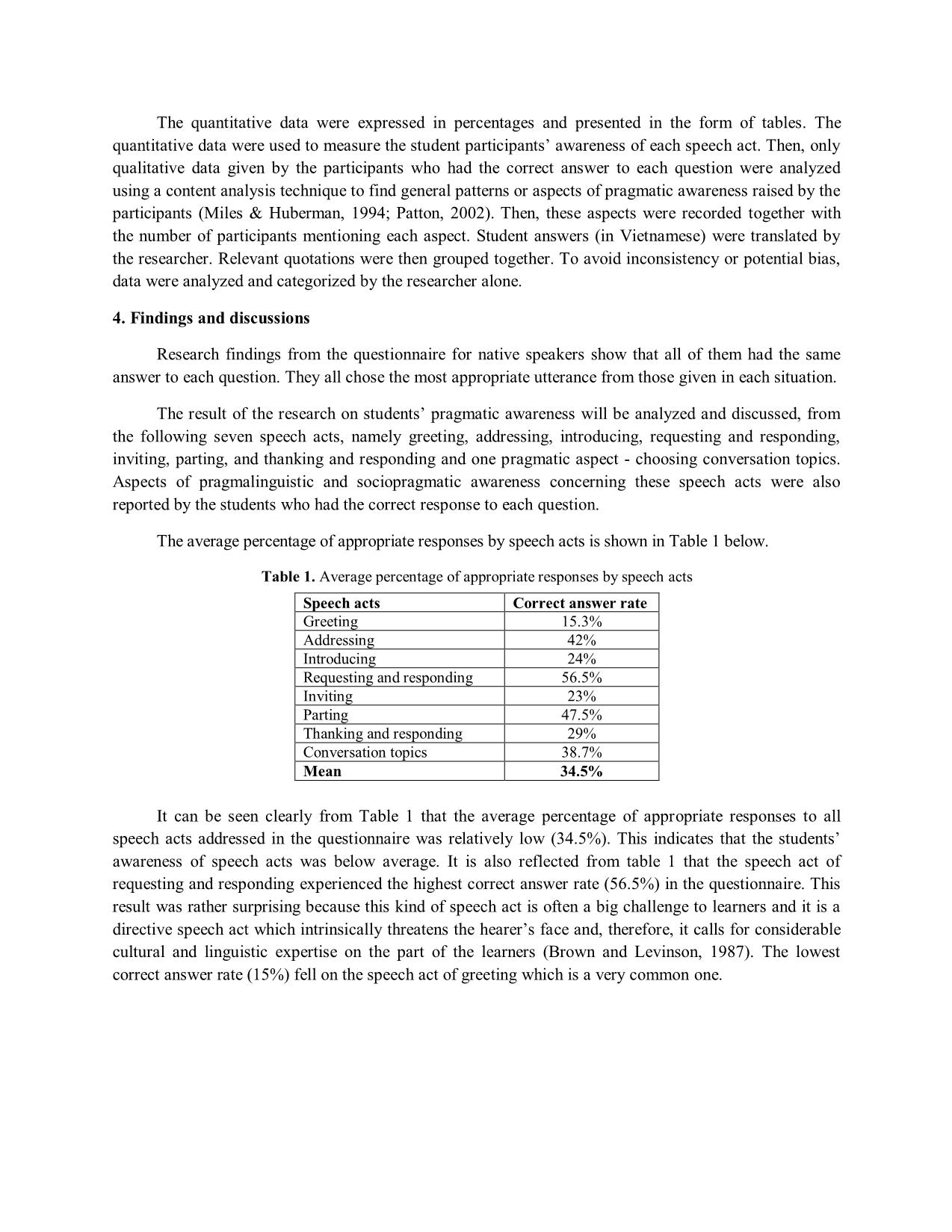
Trang 6
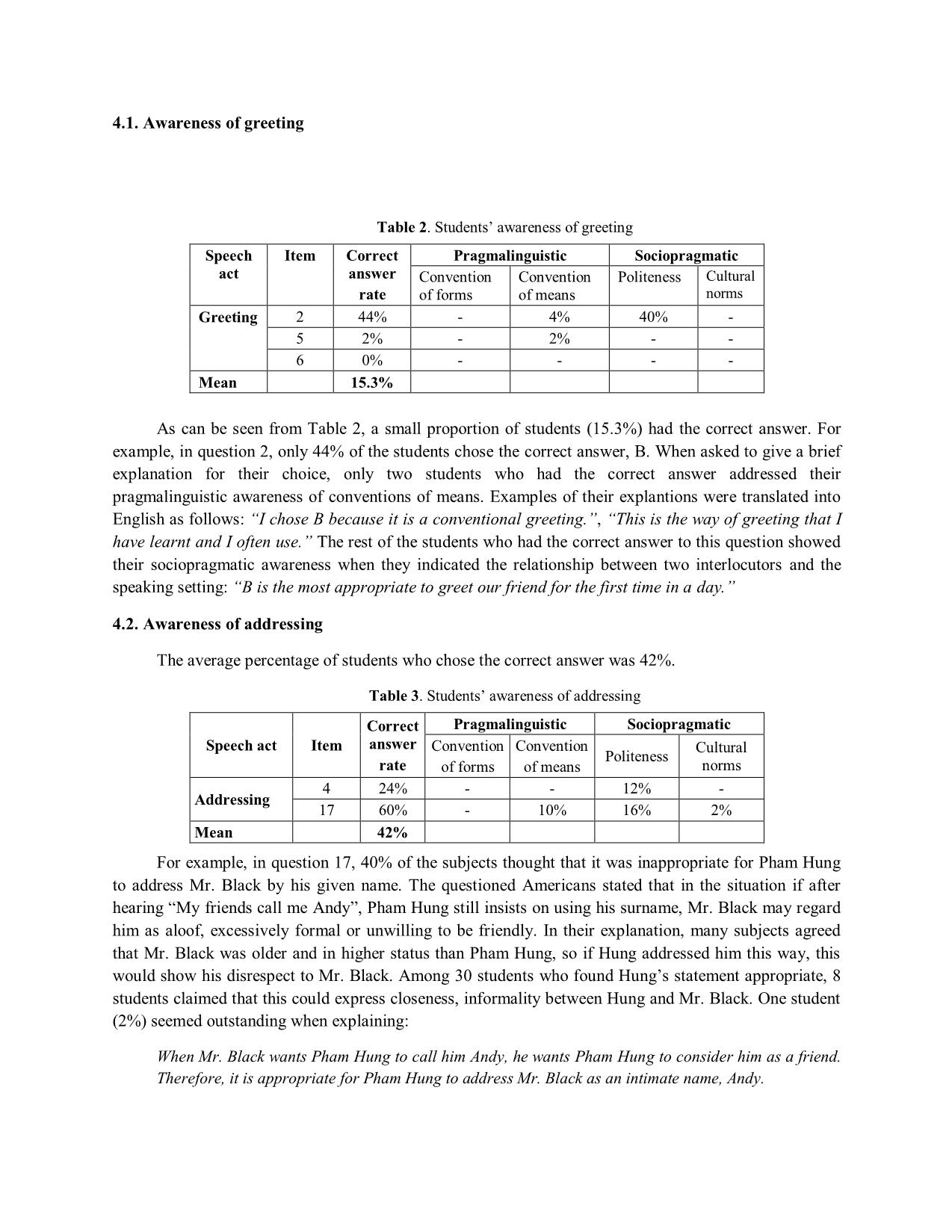
Trang 7
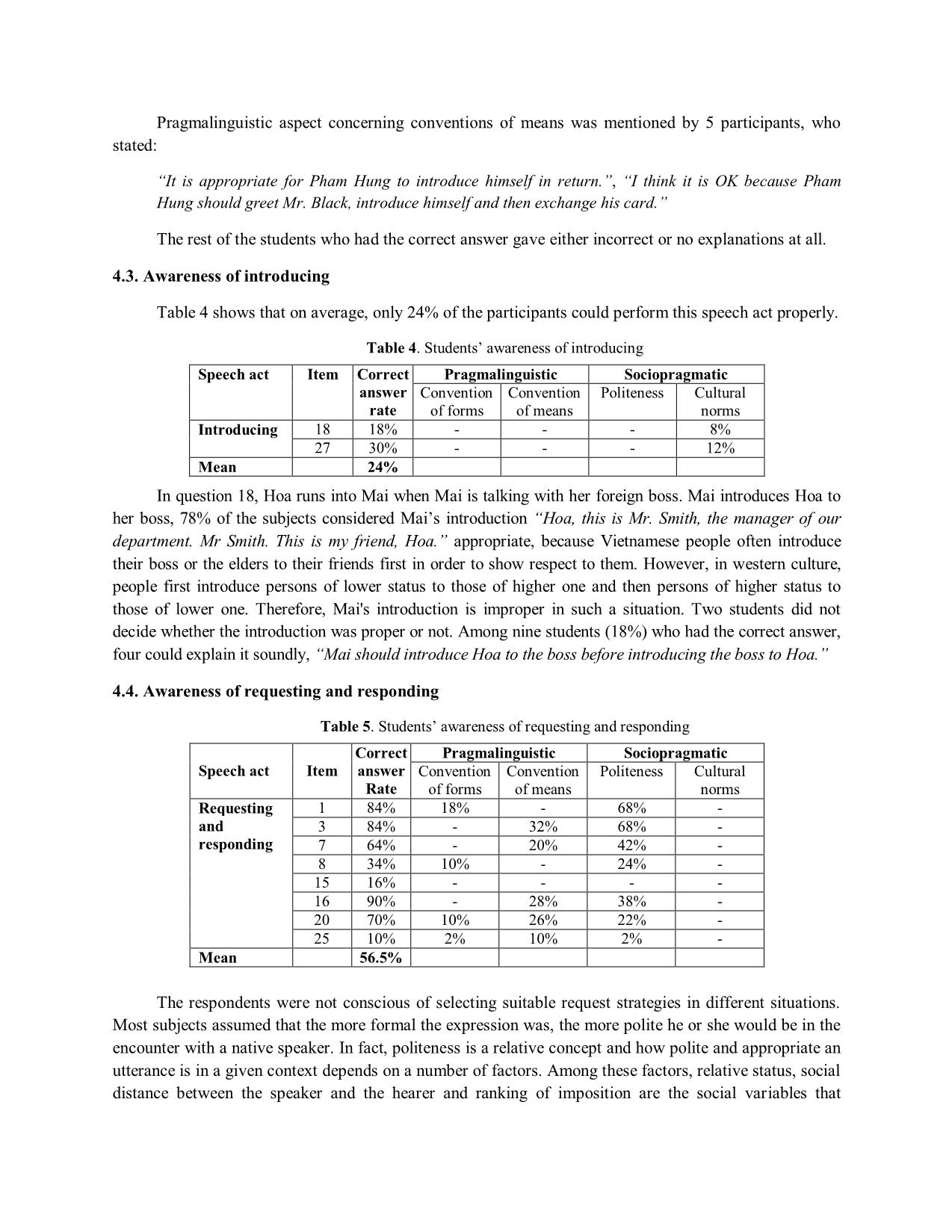
Trang 8
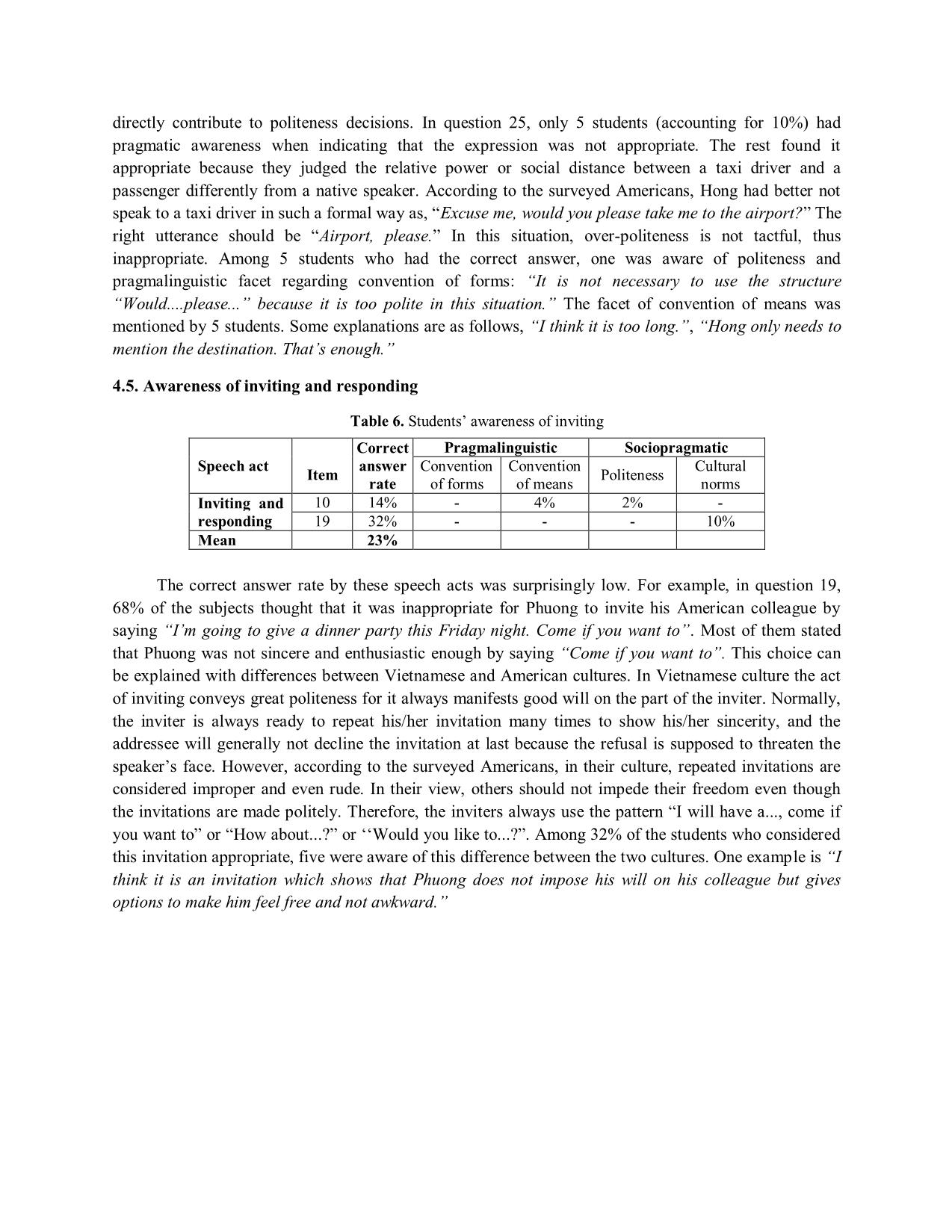
Trang 9
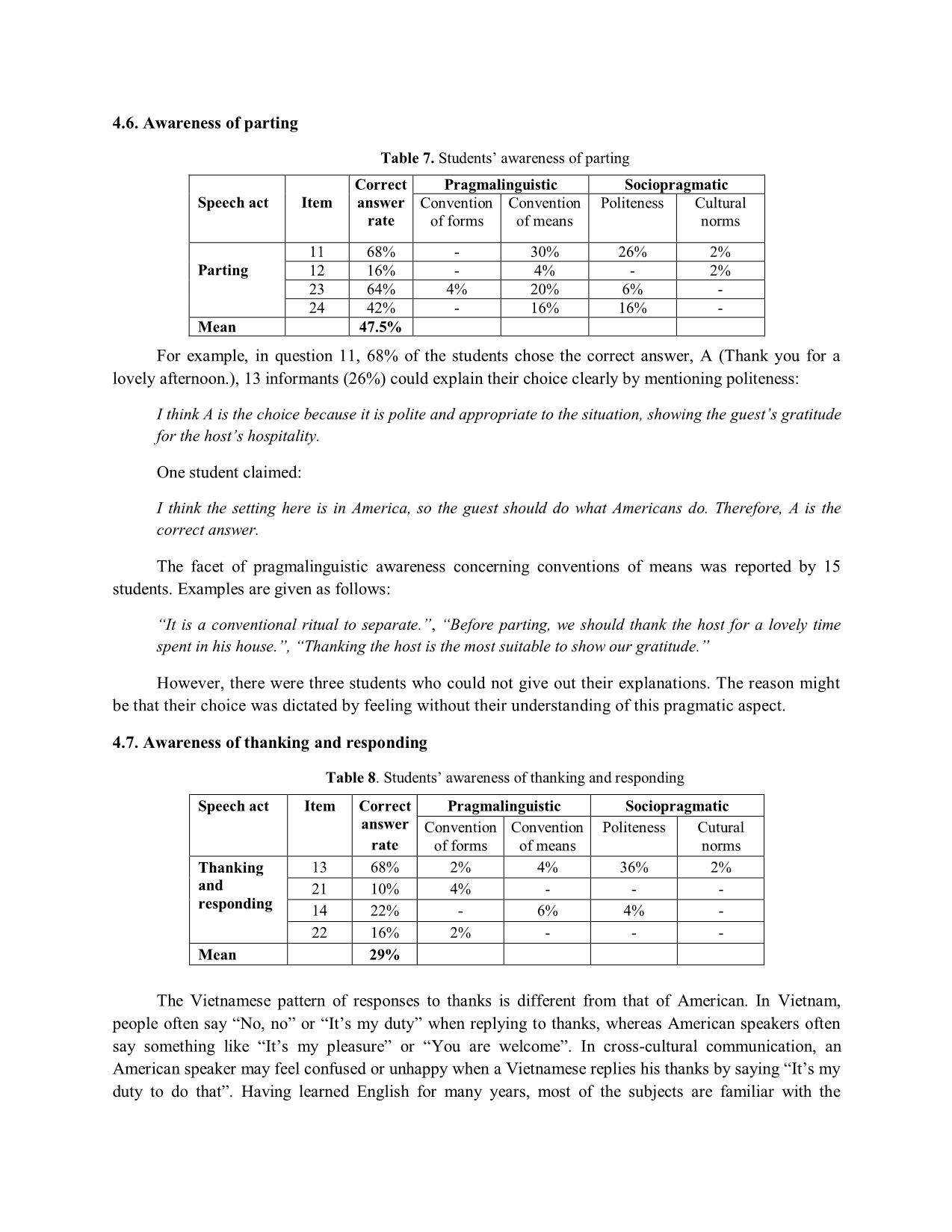
Trang 10
Tải về để xem bản đầy đủ
Tóm tắt nội dung tài liệu: Students’ pragmatic awareness and implications for english classroom teaching at Thuong Mai University
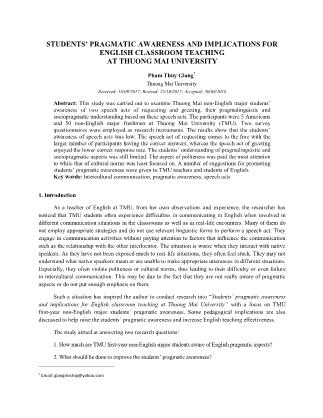
STUDENTS’ PRAGMATIC AWARENESS AND IMPLICATIONS FOR ENGLISH CLASSROOM TEACHING AT THUONG MAI UNIVERSITY Pham Thuy Giang* Thuong Mai University Received: 18/09/2017; Revised: 25/10/2017; Accepted: 30/08/2018 Abstract: This study was carried out to examine Thuong Mai non-English major students’ awareness of two speech acts of requesting and greeting, their pragmalinguistic and sociopragmatic understanding based on these speech acts. The participants were 5 Americans and 50 non-English major freshmen at Thuong Mai University (TMU). Two survey questionnaires were employed as research instruments. The results show that the students’ awareness of speech acts was low. The speech act of requesting comes to the fore with the larger number of participants having the correct answers, whereas the speech act of greeting enjoyed the lower correct response rate. The students’ understanding of pragmalinguistic and sociopragmatic aspects was still limited. The aspect of politeness was paid the most attention to while that of cultural norms was least focused on. A number of suggestions for promoting students’ pragmatic awareness were given to TMU teachers and students of English. Key words: Intercultural communication, pragmatic awareness, speech acts 1. Introduction As a teacher of English at TMU, from her own observations and experience, the researcher has noticed that TMU students often experience difficulties in communicating in English when involved in different communication situations in the classrooms as well as in real-life encounters. Many of them do not employ appropriate strategies and do not use relevant linguistic forms to perform a speech act. They engage in communication activities without paying attention to factors that influence the communication such as the relationship with the other interlocutor. The situation is worse when they interact with native speakers. As they have not been exposed much to real-life situations, they often feel stuck. They may not understand what native speakers mean or are unable to make appropriate utterances in different situations. Especially, they often violate politeness or cultural norms, thus leading to their difficulty or even failure in intercultural communication. This may be due to the fact that they are not really aware of pragmatic aspects or do not put enough emphasis on them. Such a situation has inspired the author to conduct research into “Students’ pragmatic awareness and implications for English classroom teaching at Thuong Mai University” with a focus on TMU first-year non-English major students’ pragmatic awareness. Some pedagogical implications are also discussed to help raise the students’ pragmatic awareness and increase English teaching effectiveness. The study aimed at answering two research questions: 1. How much are TMU first-year non-English major students aware of English pragmatic aspects? 2. What should be done to improve the students’ pragmatic awareness? * Email: giangmrchip@yahoo.com 2. Theoretical framework 2.1. Pragmatics Since its introduction by Morris (1938, p. 6-7) up to the present time, pragmatics has been defined in various ways by many scholars (Leech, 1983; Levinson, 1983; Mey, 1993; Rose & Kasper, 2001; Stalnaker, 1972; and Yule, 2006). Though these scholars define pragmatics differently, they all address their attention to what the speakers or writers mean. For this reason, pragmatics can be defined as “the study of the use of context to make inferences about meaning” (Fasold, 1990, p. 119). Out of numerous definitions of pragmatics, one of interest in second language pedagogy has been proposed by Crystal (in Kasper, 2001, p. 2) as “the study of language from the point of view of users, especially of the choices they make, the constraints they encounter in using language in social interaction and the effects their use of language has on other participants in the act of communication.” In other words, pragmatics is defined as the study of communicative action in its sociocultural context. Kasper (2001, p. 2) indicates that communicative actions includes not only using speech acts (such as apologizing, complaining, complimenting, and requesting) but also engaging in different types of discourse and participating in speech events of varying length and complexity. In this study, the researcher follows the division of pragmatics by Leech and Thomas (in Kasper, 2001), who classified pragmatics into two components, namely pragmalinguistics and sociopragmatics. These two aspects of pragmatics will be discussed along with the employment of speech acts. 2.2. Speech acts 2.2.1. Definitions The speech act theory is attributed to Austin (1962), who claimed “many utterances, termed performatives, do not only communicate information, but are equivalent to actions” (p. 22). In other words, by these utterances, people do things or have others do things for them; they apologize, promise, request, refuse and complain. Utterances that may be used to realize the above functions are known as speech acts. 2.2.2. Categories of speech acts Searle (1979, p. 12) provided a classification of speech acts according to their functions, dividing them into five categories, including (i) representatives, which commit the speaker to the truth of expressed proposition (paradigm cases: asserting, concluding, etc.) (ii) directives, which are attempts by the speaker to get the addressee to do something (paradigm cases: requesting, questioning, etc.) (iii) commissives, which commit the speaker to some future course of action (paradigm cases: promising, threatening, offering) (iv) expressives, which express a psychological state (paradigm cases: thanking, apologizing, welcoming, congratulating) (v) declaratives, which affect immediate changes in the institutional state of affa ... his/her sincerity, and the addressee will generally not decline the invitation at last because the refusal is supposed to threaten the speaker’s face. However, according to the surveyed Americans, in their culture, repeated invitations are considered improper and even rude. In their view, others should not impede their freedom even though the invitations are made politely. Therefore, the inviters always use the pattern “I will have a..., come if you want to” or “How about...?” or ‘‘Would you like to...?”. Among 32% of the students who considered this invitation appropriate, five were aware of this difference between the two cultures. One example is “I think it is an invitation which shows that Phuong does not impose his will on his colleague but gives options to make him feel free and not awkward.” 4.6. Awareness of parting Table 7. Students’ awareness of parting Correct Pragmalinguistic Sociopragmatic Speech act Item answer Convention Convention Politeness Cultural rate of forms of means norms 11 68% - 30% 26% 2% Parting 12 16% - 4% - 2% 23 64% 4% 20% 6% - 24 42% - 16% 16% - Mean 47.5% For example, in question 11, 68% of the students chose the correct answer, A (Thank you for a lovely afternoon.), 13 informants (26%) could explain their choice clearly by mentioning politeness: I think A is the choice because it is polite and appropriate to the situation, showing the guest’s gratitude for the host’s hospitality. One student claimed: I think the setting here is in America, so the guest should do what Americans do. Therefore, A is the correct answer. The facet of pragmalinguistic awareness concerning conventions of means was reported by 15 students. Examples are given as follows: “It is a conventional ritual to separate.”, “Before parting, we should thank the host for a lovely time spent in his house.”, “Thanking the host is the most suitable to show our gratitude.” However, there were three students who could not give out their explanations. The reason might be that their choice was dictated by feeling without their understanding of this pragmatic aspect. 4.7. Awareness of thanking and responding Table 8. Students’ awareness of thanking and responding Speech act Item Correct Pragmalinguistic Sociopragmatic answer Convention Convention Politeness Cutural rate of forms of means norms Thanking 13 68% 2% 4% 36% 2% and 21 10% 4% - - - responding 14 22% - 6% 4% - 22 16% 2% - - - Mean 29% The Vietnamese pattern of responses to thanks is different from that of American. In Vietnam, people often say “No, no” or “It’s my duty” when replying to thanks, whereas American speakers often say something like “It’s my pleasure” or “You are welcome”. In cross-cultural communication, an American speaker may feel confused or unhappy when a Vietnamese replies his thanks by saying “It’s my duty to do that”. Having learned English for many years, most of the subjects are familiar with the English formulae of responding to thanks and can accept thanks naturally in most cases. As indicated in question 13, 68% of the subjects chose the correct answer A (You’re welcome.). Among them, 18 students were aware of politeness. One student addressed convention of forms when saying, “You’re welcome” is suitable because it means “Không có gì” in Vietnamese.” The aspect of strategies was recognized by two students: “It is a popular response.” or “It is a polite response to “Thank you””. One student chose A based on her experience in watching films. The researcher put this into the cultural norm section. 4.8. Awareness of conversation topics Table 9. Students’ awareness of conversation topics Correct Pragmalinguistic Sociopragmatic Speech act Item answer rate Convention Convention Politeness Cultural of forms of means norms Conversation 9 60% - - - 10% topics 20% 26 36% - - 10% 4% Mean 38.7% The respondents showed limited knowledge of the target culture in this respect. Question 9 posed a situation in which the students had to choose more than one topic to continue a conversation with a strange person. 46% of the subjects chose A (Do you have any problems at work?), 32% chose B (Can you tell me about your family?), 4% chose D (How much you earn a month?), 12% chose E (How old are you?), 24% chose G (Are you interested in religion?) without knowing that these topics are all privacy to westerners. One student did not know what topic is suitable. There is a great difference in the students’ options of conversation topics. While over half of the students (60%) chose C (Would you like something to drink?), only one-fifth of them (20%) chose H (What do you do?) as suitable topics to discuss in their conversation. Only five students were aware of sociopragmatic aspect concerning cultural norms. Examples are as follows: “It is not acceptable to talk about private things such as age, marital status or sensitive ones like religion or problems. In this case, offering a drink can help the speakers prolong their conversation.”, “Talking about careers may be suitable in conversations with a person you meet for the first time.” 5. Implications Since the students’ low pragmatic awareness resulted from their lack of pragmatic knowledge and cultural information associated with the target language, this research presents some suggestions for TMU English teachers and students in the areas of teaching and learning pragmatics and cultures. First, teachers should raise students’ pragmalinguistic awareness by providing their students with necessary language structures and expressions to convey a speech act and reminding students that a speech act (function) can be expressed in many forms and one form can convey many functions. Second, students’ awareness of politeness should be improved. Students should be taught how to perform different speech acts in English in different situations of social status, social distance, and ranking of imposition between interlocutors. Teachers should design different contextualized activities to get students engaged in. Third, it is advisable for teachers to enhance their learners’ awareness of cultural norms by integrating culture into language teaching, enforcing the teaching of British and American cultural background, creating culture-rich learning environment, designing a cultural syllabus, providing more authentic teaching materials, improving the pragmatic teaching in the way of holding tests and exams and developing teachers’ competence. For example, when teaching the speech act of greeting, teachers should introduce cultural aspects related to this speech act and point out cultural differences between Vietnamese and the target language such as: how to greet a person for the first time, how to greet a friend, ways of greetings, etc. In addition to introducing linguistic and cultural knowledge to learners, teachers should exert more effort to help their students to apply what they have learnt in practice. Teachers can create real situations for students to participate in. For instance, the teacher first lets the students read a passage named “Dining Customs”, and then asks the students to act as waiters and customers at a restaurant in the US. Students are required to talk with each other independently. This provides a great opportunity for them to think and speak in accordance with foreign social conventions and at the same time they have to understand what other people say so as to make the conversation continue smoothly and properly. This role-play activity increases students’ awareness of the appropriate application of cultural information learnt in class and prepares them for real communication with native English speakers. Besides, in order to make sure that students fulfill the activities successfully, teachers should convey enough information about the foreign culture to students beforehand. Teachers should adopt different kinds of modern teaching aids and methods in order to strengthen the leading-in of culture, to make students have an immersed sense and learn English naturally. For instance, they could let students see English original movies, and be associated with language training program and making multimedia courseware. They can invite some foreign teachers to give a lecture and some experts to give a report, which widens the students’ outlook about culture and access a great deal of real English in order to intensify the understanding of cultural differences between Vietnam and western countries. 6. Conclusion In conclusion, by investigating students’ awareness of different facets of pragmatics, this study has been able to contribute to our knowledge of pragmatic awareness of speech acts in general and pragmalinguistic and sociopragmatic awareness in particular in ways that will benefit not only teachers but students of English as well. There are some limitations of the study that are worth mentioning. First, the scope of the study is still limited. Regarding participants, only first year students were in concern of the study. Therefore, the research results could not reflect fully students’ pragmatic awareness at TMU in general. Moreover, the small sample size (50 students) in the study can affect the generalizability of the research findings. Also, the research was done based entirely on the Americans’ responses. Therefore, only American cultural norms were of interest. Another limitation of the present study is that part of the questionnaire is multiple-choice questions. The advantage of this method is that it is relatively inexpensive, can be administered quickly to a large number of participants and allows the researcher to describe scenarios in detail. However, although a greater amount of contextual information can be provided, participants only receive written instructions, which, even if they are very precise, rely on a high degree of imagination on the participants’ part, since they can neither hear nor see the conversation in its context. As a consequence, participants have to imagine the speakers’ tone and facial expressions, which might lead to different assessments of the scenarios based on the individual participants’ ideas of how an utterance was intended by the speaker. References Austin, J.L. (1962). How to do things with words. Oxford: Clarendon. Bardovi-Harlig, K., & Griffin, R. (2005). L2 Pragmatic awareness: evidence from the ESL classroom. System, 33(3), 401-415. Brown, P., & Levinson, S. (1978). Universals in language usage: politeness phenomena. In E.N. Goody (Ed.), Questions and politeness: strategies in social interaction (pp. 56-299). Cambridge: Cambridge University Press. Brown, P., & Levinson, S. (1987). Politeness: some universals in language usage. Cambridge: Cambridge University Press. Cook, M., & Liddicoat, A.J. (2002). The development of comprehension in interlingua pragmatics: the case of request strategies in English. Australian Review of Applied Linguistics, 25(1), 19-39. Fasold, R. (1990). Sociolinguistics of language. Oxford and Cambridge (US): Blackwell. Garcia, P. (2004). Developmental differences in speech acts recognition: a pragmatic awareness study. Language Awareness, 13(2), 96-115. Hinkel, E. (1997). Appropriateness of advice: DCT and multiple choice data. Applied Linguistics, 18(1), 1-26. Holmes, J. (2001). An introduction to sociolinguistics. England: Pearson Education Limited. Kasper, G. & Roever, C. (2005). Pragmatics in second language learning. In E. Hinkel (Ed.), Handbook of research in second language teaching and learning (pp. 317-334). New Jersey: Lawrence Erlbaum. Kasper, G. (1996). Introduction: pragmatics in SLA. Studies in Second Language Acquisition, 18(2), 135-148. Kasper, G. (1997). Can pragmatic competence be taught?. University of Hawaii: Second Language Teaching and Curriculum Center. Kasper, G. (2001). Four perspectives on L2 pragmatic development. Applied Linguistics, 22(4), 502-530. Leech, G. (1983). Principles of pragmatics. London: Longman. Levinson, S. (1983). Pragmatics. Cambridge: Cambridge University Press. Malinowski, B. (1994). The problem of meaning in primitive languages. London: Routledge & Kegan Paul. Mey, J. (1993). Pragmatics: an introduction. Oxford, UK: Blackwell. Miles, M.B., & Huberman, A.M. (1994). Qualitative data analysis (2nd edition). Thousand Oaks, CA: Sage Publications. Morris, C.H. (1938). Foundation of the theory of signs. In. O. Neurath (Ed.), International encyclopedia of unified science (vol. 1) (pp. 77-138). Chicago: University of Chicago Press. Patton, M.Q. (2002). Qualitative research and evaluation methods (3rd version). Thousand Oaks, CA: Sage Publications. Rose K.R., & Kasper, G. (2001). Pragmatics in language teaching. Cambridge: Cambridge University Press. Schauer, G. (2006). Pragmatic awareness in ESL and EFL contexts: contrast and development. Language Learning, 56(2), 269-318. Schmidt, R. (1990). The role of consciousness in second language learning. Applied Linguistics, 11(2), 129-158. Schmidt, R. (1994). Implicit learning and the cognitive unconscious: of artificial grammars and SLA. In N. Ellis (Ed.), Implicit and explicit learning of languages (pp. 165-209). London: Academic Press. Schmitt, N. (2002). Vocabulary in language teaching. Cambridge: Cambridge University Press. Searle, J.R. (1979). Expression and meaning; studies in the theory of speech acts. Cambridge, UK: Cambridge University Press. Stalnaker, R. (1972). Pragmatics. In G. Harman & D. Davidson (Eds.), Semantics of natural language (pp. 380-397). Dordrecht: Reidel. Yule, G. (2006). The study of language. UK: Cambridge University Press.
File đính kèm:
 students_pragmatic_awareness_and_implications_for_english_cl.pdf
students_pragmatic_awareness_and_implications_for_english_cl.pdf

